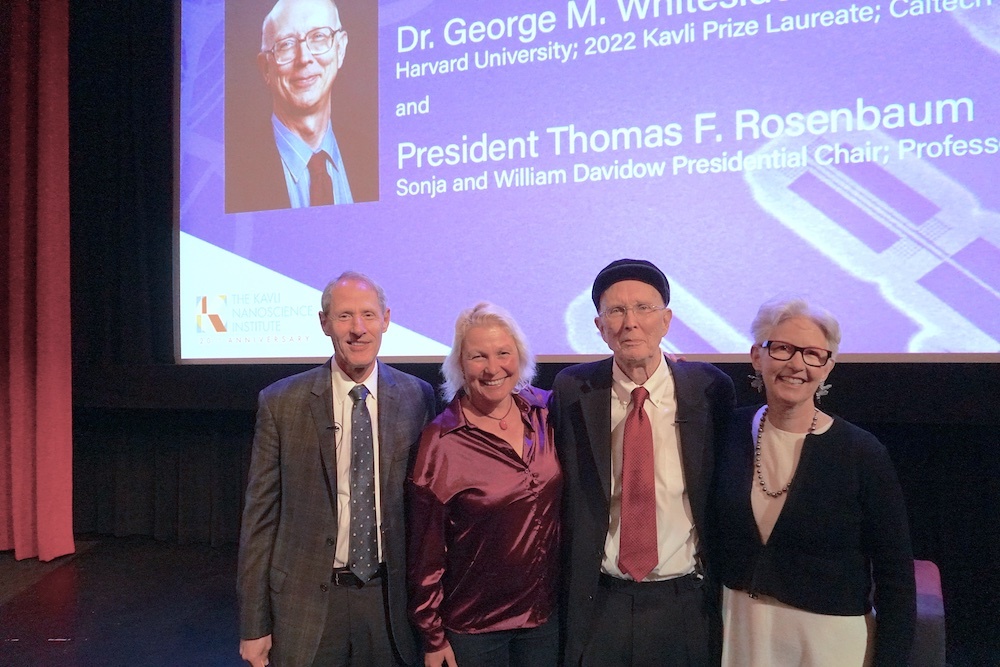Kavli Nanoscience Institute Celebrates 20 Years
At Caltech, the science of the small has a big moment
The Kavli Nanoscience Institute (KNI) at Caltech is celebrating two decades of discovery and innovation.
“The KNI has evolved into a community-serving center of excellence to promote nanoscience,” said Julia R. Greer, Ruben F. and Donna Mettler Professor of Materials Science, Mechanics and Medical Engineering and the Fletcher Jones Foundation Director of the Kavli Nanoscience Institute.
The KNI became the foundation’s first institute in nanoscience when it was announced at a press event in New York led by Kavli Foundation founder Fred Kavli and then-president David Auston. The initial vision laid out by a “Nanoscale Sciences Initiative” committee co-chaired by Michael Roukes (KNI’s founding director) and Axel Scherer was bold and exciting. The KNI would foster innovative, interdisciplinary research at the frontiers of nanoscale science and engineering. It would create new research opportunities and foster an extended community of scientists to exchange ideas and develop collaborative partnerships.
“President Clinton made the choice to come to Caltech to announce the launch of the U.S. National Nanotechnology Initiative, and shortly after this we were fortunate to receive funding for our new institute from the Moore Foundation and The Kavli Foundation,” said Michael Roukes, Frank J. Roshek Professor of Physics, Applied Physics, and Bioengineering, who served as inaugural director of the Kavli Nanoscience Institute from 2004-2008. “This permitted a transformative change-of-paradigm for us, enabling centralized facilities for nanofabrication that became accessible to the entire university.”
With the first 20 years under its belt, the KNI community has done that and more. At its KNI20 event on March 7th and 8th on the Caltech campus, the community celebrated their many achievements and painted a picture of the future of the field and their role in it.

A key element of the institute is its world-class KNI Laboratory, a 7,500-sq.-ft. multi-user nanofabrication and characterization facility, with the latest instrumentation in lithography, deposition, etching, microscopy, and more. The laboratory facilities are the enabling force behind research at this scale, where the opportunities and challenges of nanoscience converge.
“We need to have special equipment and capabilities to enable first the fabrication and manipulation of nanomaterials and nano-devices and then the characterization of their properties and performance,” said Greer. “We need special equipment from deposition, lithography, and etching to post-processing, thermal treatment, and overall characterization and performance assessment, with imaging and inspection steps all along the way.”
Empowered by the state-of-the-art instrumentation tools and a knowledgeable, research-savvy, supportive community, researchers at the KNI have made great strides in nanoscience in the institute’s first 20 years, from 2D materials (such as graphene and more recently, transition metal dichalcogenides), to data and energy storage (from qubits and quantum memory to photovoltaics and solid-state batteries), and advanced, multi-scale hierarchical materials with unprecedented properties.
But, as any KNI member will attest, it’s the people that make the institute a success. Some of the brightest leaders in nanoscience belong to this thriving community, and during the institutes last 20 years, they have made incredible strides in the science of the small.
Greer mentions breakthroughs such as Michael Roukes’s group fabricating a single photon detector, enabling them to image materials at the atomic scale; how Harry Atwater and his team demonstrated record photovoltaic performance; and how her own group was able to make the smallest, most lightweight, and mechanically robust battery. Additionally, Andrei Faraon pioneered using rare-earth-doped crystals in quantum nano-photonic devices.
With an eye to the future, the institute continues to emphasize opportunities for students and early-career researchers with support for awards, scholarships, and fellowships. “Because at the end of the day, it’s really our students that really are ultimately the vision of the KNI," said Greer. “We start with nano students and produce big deal scientists.”